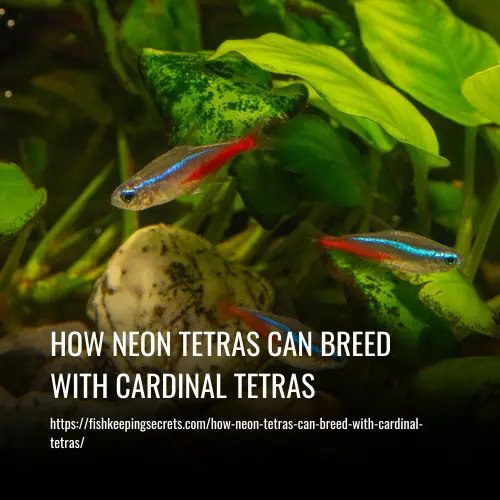Neon tetras and cardinal tetras are two popular and colorful species of freshwater fish that are often kept in home aquariums. While they are similar in appearance, they are different species and are not typically known to interbreed. However, in rare cases, it is possible for neon tetras and cardinal tetras to successfully breed and produce offspring.
Understanding how neon tetras can breed with cardinal tetras can provide valuable insights for fish enthusiasts and breeders, as well as contribute to our knowledge of the fascinating world of freshwater fish reproduction.

How Neon Tetras Can Breed With Cardinal Tetras
Neon tetras and cardinal tetras are both popular species of aquarium fish, and they belong to the same family known as Characidae. While they are closely related, they are still distinct species and are typically kept separate in aquariums. However, it is possible for neon tetras and cardinal tetras to interbreed under certain conditions.
Interbreeding can occur when there is a lack of suitable mates within their own species. In some cases, if a tank only has one species of tetra, the opposite species may be seen as a viable mate. This can lead to breeding and the production of hybrid offspring.
It is important to note that hybrid offspring may not be as healthy or vibrant as purebred neon or cardinal tetras. They may also have different coloration and patterns compared to their parent species. Breeders and hobbyists often prefer to keep pure strains of each species to maintain their distinct characteristics and traits.
If you want to prevent interbreeding between neon tetras and cardinal tetras, it is recommended to keep them in separate tanks or ensure that there are enough suitable mates of their own species available. This will help preserve the genetic integrity of each species and maintain their unique traits in aquarium populations.
Housing for Breeding Neon Tetras and Cardinal Tetras
Breeding neon tetras and cardinal tetras can be done in a separate breeding tank. The tank should be at least 10 gallons in size and should have a heater to maintain a temperature between 73 and 80 degrees Fahrenheit. Provide plenty of plants, such as java moss or floating plants, for the fish to lay their eggs on and for the fry to hide in.
Use a sponge filter to provide gentle filtration without sucking up the tiny fry. The water should be soft and slightly acidic. Feed the adult fish a varied diet of high-quality flakes, pellets, and live or frozen foods. The fry can be fed infusoria or liquid fry food until they are big enough to eat crushed flakes or baby brine shrimp.
Monitor the water parameters regularly and perform regular water changes to keep the breeding tank clean and healthy for the fish.
Breeding Habits of Neon Tetras and Cardinal Tetras
Neon tetras and cardinal tetras are both small tropical fish that are popular in aquariums. Here are their breeding habits:
1. Neon Tetras
Neon tetras are egg scatterers, which means that the female will scatter her eggs among plants or other surfaces in the aquarium. The male will then fertilize the eggs. After spawning, the parents should be removed from the tank as they may eat the eggs. The eggs will hatch in 24 to 36 hours and the fry will become free-swimming after a few days. The fry can be fed infusoria or commercially available liquid fry food.
2. Cardinal Tetras
Cardinal tetras are similar to neon tetras in terms of breeding habits. The female will scatter her eggs among plants or other surfaces, and the male will fertilize them. Once the eggs are fertilized, the parents should be removed as they may eat the eggs. The eggs will hatch in about 24 to 36 hours and the fry will become free-swimming after a few days. Like neon tetra fry, cardinal tetra fry can be fed infusoria or commercially available liquid fry food.
Breeding neon tetras and cardinal tetras in captivity can be challenging, as they require specific water conditions and a well-maintained aquarium. It is often best left to experienced breeders.
Mating Habits of Neon Tetras and Cardinal Tetras
The mating habits of Neon Tetras and Cardinal Tetras are similar. Both species are egg scatterers, meaning that they release their eggs into the water where they are left to be fertilized. The males of both species will chase the females, often displaying vibrant colors and engaging in elaborate courtship dances.
Once the female releases her eggs, the male will fertilize them by releasing his sperm. After spawning, the adults will usually eat the eggs, so it is important to remove the adults from the breeding tank if you want to successfully raise the fry. The eggs will hatch within a few days, and the fry will need to be fed small live or frozen foods until they are large enough to eat regular fish food.
Temperament Differences Between Species
Neon tetras and cardinal tetras have some temperament differences. Neon tetras are generally more peaceful and can be kept in larger groups without aggression issues. They are known for their shoaling behavior and prefer to be in schools.
On the other hand, cardinal tetras can be slightly more aggressive, especially during breeding season. They may exhibit fin-nipping behavior towards other fish if they feel threatened or stressed. It is important to provide both species with plenty of hiding places and space to establish territories to help mitigate any potential aggression.
Feeding Requirements for Breeding Neon Tetras and Cardinal Tetras
Breeding neon tetras and cardinal tetras require a well-balanced diet consisting of live or frozen food. They should be fed small, high-quality foods such as brine shrimp, daphnia, and mosquito larvae. It is important to vary their diet to provide a good range of nutrients.
Additionally, these fish should be fed multiple times a day in small amounts to ensure they receive enough food. It is also recommended to provide them with a vegetable-based flake or pellet food to supplement their diet and provide additional nutrients.
The Role of pH Levels in Breeding Neon Tetras and Cardinal Tetras
When it comes to breeding Neon Tetras and Cardinal Tetras, one of the most important factors is the pH levels in the water. Knowing the correct pH for breeding these fish can mean the difference between success and failure. I’ve found that Neon Tetras and Cardinal Tetras prefer a slightly acidic environment, with pH levels between 6.5-7.0 being ideal for successful spawning. If the pH levels are too low or too high, this can cause stress in the fish which can inhibit breeding success.
It’s also important to note that when keeping both species together, they will be competing for food if their pH requirements differ significantly. Therefore, it’s best to keep them in separate tanks with similar pH levels to ensure there is enough food for each species without competition from other fish.
To make sure that my aquariums have the right pH values I regularly test them using an aquarium test kit so I know exactly what adjustments need to be made if necessary to optimize my chances of successful breeding.
Common Reproductive Diseases Affecting Neon Tetra Fish
The common reproductive diseases that can affect neon tetra fish diseases include bacterial infections and parasites, which can cause a variety of symptoms such as abnormal swimming behavior and swollen eyes. They can also be carriers of more serious illnesses such as fin rot and dropsy.
In order to prevent these diseases from affecting fish, it is important to take several steps to ensure they are living in a healthy environment. This includes regular water changes to keep their tank clean, providing them with plenty of oxygenated water and avoiding overfeeding. Additionally, make sure to provide adequate hiding spots for your fish so they feel secure in their tank.
Common symptoms include lethargy, loss of appetite, weight loss and pale coloring around the gills or eyes. If you notice any of these signs in your fish, take immediately isolate the affected fish to prevent the disease from spreading to other members of the community tank.
It’s important to always be vigilant when it comes to your Neon Tetra Fish’s health so you can catch any issues early on before they become too severe!
FAQs
Yes, neon tetras (Paracheirodon innesi) and cardinal tetras (Paracheirodon axelrodi) are closely related and can breed together to produce hybrid offspring.
Males will display more intense colors and act more aggressively towards females. Females will appear more rounded when carrying eggs.
You can stimulate breeding by gradually raising the water temperature, providing plenty of live food, and adding more plants to the tank.
Yes, both species can live together peacefully, but if you want to breed them, it’s best to create a separate breeding tank with the right conditions.
The fry resulting from the breeding of Neon and Cardinal Tetras will be a mix of both species, but they are generally infertile and cannot be used in further breeding.
After the female lays her eggs, it takes about 24 hours for the eggs to hatch, and the fry will become free-swimming after approximately 4-7 days.
The ideal tank conditions for breeding Neon and Cardinal Tetras include slightly acidic water with a pH level between 5.5 and 6.5, a temperature of 75-80°F, and dim lighting to encourage spawning.
Neon Tetras have a blue stripe that runs horizontally along their body, while Cardinal Tetras have a red stripe, and Neon Tetras are smaller in size compared to Cardinal Tetras.
Conclusion
In conclusion, it is clear that neon tetras and cardinal tetras can breed successfully under the right conditions. By creating an environment that mimics their natural habitat and providing suitable water parameters, breeders can encourage successful mating and spawning between these two species.
It is important to note that proper research and understanding of the breeding process is crucial to ensure the health and well-being of the fish. Additionally, it is recommended to seek guidance from experienced breeders or aquarists when attempting to breed neon and cardinal tetras.


